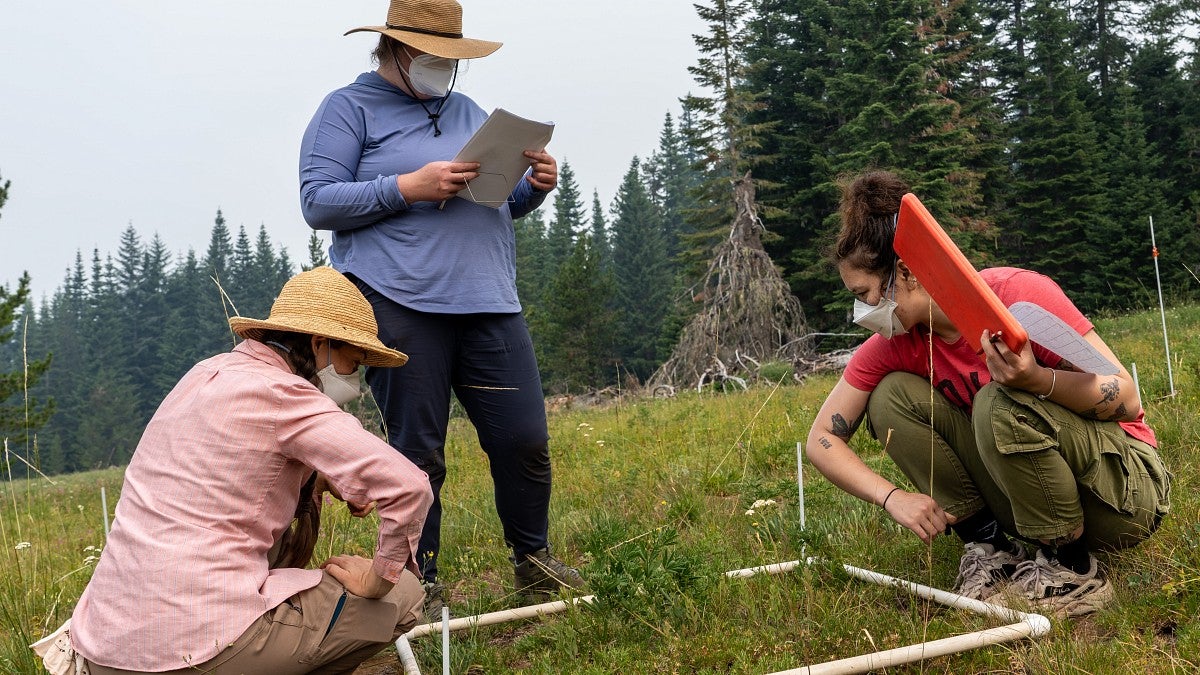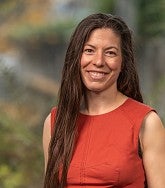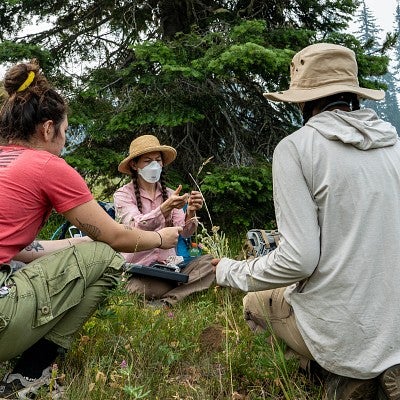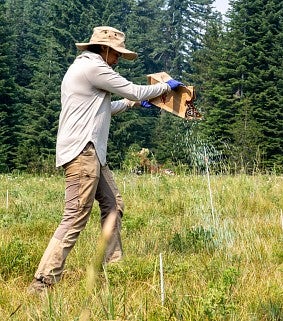
August 6, 2024 - 10:00am
After many turns and one locked gate, six researchers reach the end of a US Forest Service road. They step from their vehicle into eerie, golden light. The cool air carries the smell of smoke, so they don layers and N95 masks before following an overgrown trail through the forest.
Associate Professor Lauren Hallett and other members of her lab in the College of Arts and Sciences Department of Biology and Environmental Studies Program are at Bunchgrass Meadows to collect data for the Nutrient Network, a web of 130 sites around the world that monitor how nutrient addition affects biodiversity loss. The resulting data will provide a foundation for research that helps predict and reduce this loss.
The Nutrient Network is a grassroots effort that began in response to a major global change. Since industrialization, fossil fuel combustion and agricultural fertilization have doubled the amount of nitrogen on the planet.
“When you add that much change to plant dynamics, it’s often with deleterious results,” Hallett says. “You lose plant diversity. This group started trying to understand why that is—and how strong the effect is.”
While it is well-known that nutrient addition generally reduces biodiversity, why this is—and whether it depends on context—is a key question best answered with globally-replicated studies.
Studying plant diversity from the grassroots up
The Nutrient Network uses a grassroots network approach to scientific research, recruiting researchers and citizen scientists from around the globe to help collect and contribute data to a larger, ongoing effort.

“Growing the Nutrient Network paves the way for us to do this grassroots-style, cross-site comparison,” Hallett says. “It’s a collaborative approach to science that is catching on. The model has a lot of utility in terms of bringing people together.”
Hallett, who recently received a US Fulbright Global Scholar award in environmental studies, plans to use part of the funds to travel to the University of Buenos Aires, where she’ll collaborate with colleagues she met through the Nutrient Network. While there, she’ll teach data management workshops for some of their students.
"My goal is to bring some of the data management and visualization skills I teach in my course here and share them with my colleagues’ students. We’re excited about that,” she says.
Monitoring local biodiversity
The Nutrient Network’s 130 sites are divided into plots containing varying combinations of nitrogen, phosphorus and potassium. Researchers across the globe monitor the plants’ response to this addition each year, with some sites approaching 20 years of data.

The Hallett Lab monitors two of these sites—including Bunchgrass Meadows, where the team splits into groups to study different components of biodiversity.
The plant composition group estimates the number of species in a one-meter-squared PVC frame, a 10-centimeter-squared wire frame, and the whole five-meter-squared plot. By measuring the plant composition in different areas, they can learn how nutrient addition affects the well-studied relationship between the number of species and the size of the area.
Meanwhile, the biomass group places a couple of meter sticks 10 inches apart and cuts all the plants in between. They place the vegetation into paper bags labelled with the plot number.
Some of the bags have lost their labels. The insects at Bunchgrass Meadows consume twice as many plants as those at any other site. They also eat paper bags—and their labels. Hallett is well prepared with extra bags and permanent markers.
Building community across disciplines
Collecting data for the Nutrient Network helps Hallett’s lab build community and share skills. For some lab members, their involvement ends there. Others, however, have conducted their own research projects based on Nutrient Network data.
Andrew Muehleisen is one of the latter. Now director of undergraduate studies in the School of Computer and Data Sciences, Muehleisen started at the University of Oregon as a joint postdoctoral scholar with the Institute of Ecology and Evolution and the Data Science Initiative.

To help uncover how nutrient addition causes biodiversity loss, he analyzed data from 30 Nutrient Network sites, including Bunchgrass, to compare how many species joined each community versus how many species disappeared. His findings, published in a 2022 Journal of Ecology article, showed that nutrient addition predominantly causes biodiversity loss by pushing more species to local extinction.
“They can show up, they can briefly establish. But they couldn’t stay, they could not persist,” Muehleisen says.
It's an important discovery for land managers. Current practices of reseeding an area to restore species may not be effective if they are not paired with practices that prevent local extinction.
Back at Bunchgrass Meadows, the smoke clears, revealing a pastel blue sky and fluffy clouds on the horizon. The Hallett Lab researchers begin to shed their layers and masks.
With data collection complete, they move on to their final task. They zig zag through each plot, tossing handfuls of fertilizer into the air as they go. Each toss is answered by a burst of crickets. They are adding nutrients to the site, setting it up for years of monitoring and research to come.
—By Vishva Nalamalapu, College of Arts and Sciences
